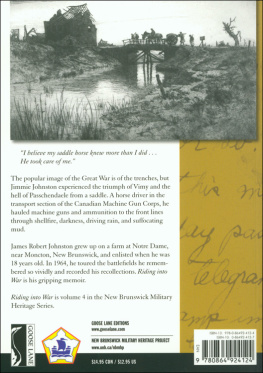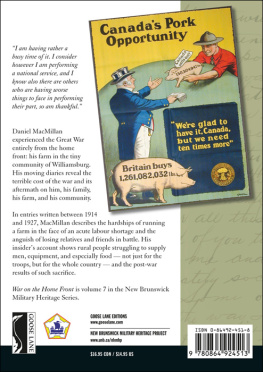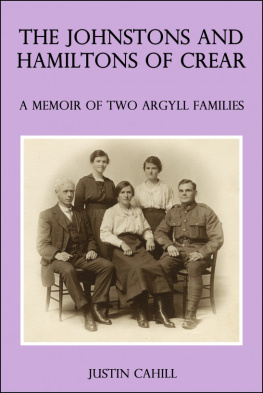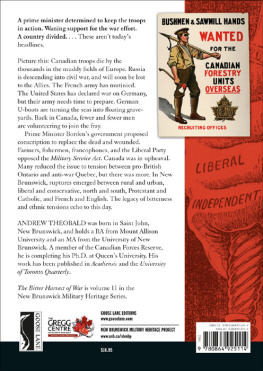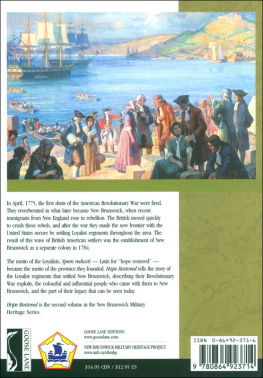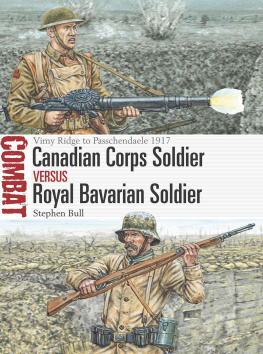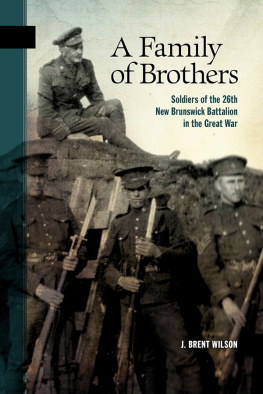Riding into War
The Memoir of a Horse Transport Driver, 1916-1919
Riding into War
The Memoir of a Horse Transport Driver, 1916-1919
by JAMES ROBERT JOHNSTON
The New Brunswick Military Heritage Series, Volume 4
Copyright Estate of James Robert Johnston, 2004.
All rights reserved. No part of this work may be reproduced or used in any form or by any means, electronic or mechanical, including photocopying, recording, or any retrieval system, without the prior written permission of the publisher or a licence from the Canadian Copyright Licensing Agency (Access Copyright). To contact Access Copyright, visit www.accesscopyright.ca or call 1-800-893-5777.
Edited by Brent Wilson.
Cover illustrations: Front detailed from Pack horses transporting ammunition to the 20th Battery, Canadian Field Artillery. W.I. Castle/National Archives of Canada/PA-001231;
Back Entering Ypres at Dawn by Cyril H. Barraud, AN19710261-0936, Beaverbrook Collection of War Art, Canadian War Museum.
Cover and book design by Julie Scriver.
Printed in Canada by Transcontinental.
10 9 8 7 6 5 4 3 2 1
Library and Archives Canada Cataloguing in Publication
Johnston, James Robert, 1897-1976
Riding into war: the memoir of a horse transport driver, 1916-1919 / James Robert Johnston.
(New Brunswick military heritage series; 4)
Includes index.
Co-published by New Brunswick Military Heritage Project.
ISBN 0-86492-412-7
1. Johnston, James Robert, 1897-1976. 2. Canada. Canadian Army. Canadian Machine Gun Corps Biography. 3. World War, 1914-1918 Transportation. 4. World War, 1914-1918 Personal narratives, Canadian. I. New Brunswick Military Heritage Project II. Title. III. Series.
D640.J55 2004 940.48171 C2004-904454-0
Published with the financial support of the Canada Council for the Arts, the Government of Canada through the Book Publishing Industry Development Program, the New Brunswick Culture and Sports Secretariat, the Canadian War Museum, and the Military and Strategic Studies Program at the University of New Brunswick.
GOOSE LANE EDITIONS
Suite 330, 500 Beaverbrook Court
Fredericton, New Brunswick
CANADA E3B 5X4
www.gooselane.com
NEW BRUNSWICK MILITARY HERITAGE PROJECT
Military and Strategic Studies Program
Department of History, University of New Brunswick
PO Box 4400
Fredericton, New Brunswick
CANADA E3C 1M4
www.unb.ca/nbmhp
Contents
Chapter One
Joining Up and Going Overseas
April 1916 November 1916
Chapter Two
To the Front
November 1916 April 1917
Chapter Three
From Vimy to Passchendaele
April 1917 November 1917
Chapter Four
On the Move
November 1917 July 1918
Chapter Five
Victory and Homecoming
July 1918 June 1919
Horse transport moving through the ruins of Bourlon, October 1918. NAC/PA-003332
Introduction
In March 1917, Private James Robert Johnston of the 14th Canadian Machine Gun Company entered the trenches of the Western Front for the first time below Vimy Ridge. Within a few weeks, he was transporting supplies and equipment across the ridge to newly captured German dugouts, after having participated in the Canadian Corps greatest victory to date. Over the next year and a half, Johnston fought in many of the Corps other major battles, including Hill 70, Passchendaele, Amiens, Bourlon Wood, and Valenciennes. After five months in garrison in Belgium following the Armistice, he finally returned home to New Brunswick in June 1919. Twenty-one years old, a three-year veteran of the First World War, he was filled with experiences that remained vivid in his memory for the rest of his life.
James Johnston was born in Boston on Christmas Day, 1897, after his parents moved from the Moncton area to Massachusetts. When Jimmie was five years old, they returned to New Brunswick, settling in Notre Dame, near Moncton. There he attended school until grade eight. After leaving school, he worked mostly in the woods because his father ran a logging camp. In the off-season, he held a variety of farm jobs.
In April 1916, he felt restless working in the lumber woods in Nova Scotia with his father, and at age eighteen he decided to enlist in the Canadian Army. He joined the 145th Battalion at Moncton; after several months of training at Sackville, southeast of Moncton, his unit moved to Camp Valcartier, near Quebec City, the main training camp for Canadian troops preparing to deploy overseas. They arrived in England in October, and by early November, only seven months after joining up, he was in France with the 26th New Brunswick Battalion. This battalion had been raised in New Brunswick in November 1914, and it served with the 2nd Canadian Division in France between 1915 and 1918. Popularly known as The Fighting 26th, it was one of only two infantry battalions from New Brunswick to see active service at the front.
Johnstons first grade class, Dorchester, Massachusetts, 1903. Johnston stands in the back row, third from the right. JFC
In January 1917, Johnston volunteered for the Canadian Machine Gun Corps, and in April he went into action in the Battle of Vimy Ridge as a member of the transport section of the 14th Canadian Machine Gun Company. Later in the year, he was drawn into Hell the Battle of Passchendaele. Following a period of leave in London, he returned to the front, where he contracted the mumps and then a fever, which caused him to spend several weeks in hospital.
On March 21, 1918, the Canadian Machine Gun Corps amalgamated its companies to form large battalions. The 14th joined the 4th, 5th, and 6th Companies to form the 2nd Canadian Machine Gun Battalion. Johnston served with the 2nd until he was transferred to the 4th C.M.G. Battalion on June 18, 1918, and there he finished out the war. When the end of the fighting finally came on November 11, he was at Le Havre on leave. After the Armistice, he spent the winter in Belgium, near the battlefield of Waterloo. It was not until April 1919 that he left for Canada; he reached Saint John in June, where he was discharged, and he returned to Notre Dame.
Following the war, Johnston lived with his family and worked at various jobs, including at Lockharts sawmill. In 1922, he moved to Boston and became a steam fitter in Bethlehems and other shipyards. He married Edith Geddes of Gladeside, New Brunswick, in 1929, and in 1932 their daughter Anna was born. When the shipyards closed during the Depression, the family returned to Notre Dame, where Johnston found employment at Taylors General Store. Around 1935, he began working for K.C. Irving, scaling lumber in Kent County and installing fuel tanks, until he was hired by the Canadian National Railway in 1940 as a steam fitter. Two sons, Don and Ralph, were born in Moncton in 1941 and 1944. Apart from a year in Newfoundland in 1954-1955, Johnston remained with C.N. in Moncton until he retired in 1962, and then he worked as a commissionaire until he was seventy-two years old. He died on August 28, 1976, at age seventy-eight, and was buried at Fairhaven Cemetery in Moncton; Edith passed away in July 2000.
Like many Great War veterans, Johnston never forgot his experiences in France and Flanders, although he lost touch with many of his wartime comrades when he was separated from them, both during and after the war. After he went to hospital in March 1918, he never again saw one of his closest friends, Bill (Guy) Barkley. However, chance meetings kept memories of the war alive for him. About 1922, he met another close friend, Danny (Nick) Nicholson, in Boston. At the same time, in a strange coincidence, Johnston was at work in a Boston shipyard when a new pipe fitter came up to him, and they started talking. Johnston told him he had better put his cap on, because he was getting oil in his hair. The man said that he could not wear a cap. He had a silver plate in his head, and wearing a cap bothered him; he had been shot down over France while in the Royal Flying Corps. Questioning him, Johnston found out that the man was the flyer he had seen shot down over Ypres in November 1917. In later years, Johnston renewed old wartime friendships as an active member of the 145th Battalion Veterans Association.
Next page
